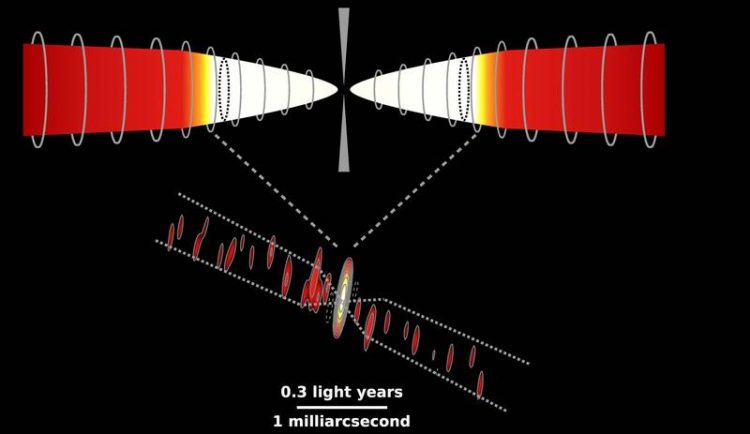Twin jets pinpoint the heart of an active galaxy

3-mm GMVA image of NGC 1052 showing a compact region at the centre and two jets (bottom), and a sketch with an accretion disk and two regions of entangled magnetic fields forming two jets (top). Anne-Kathrin Baczko et al., Astronomy & Astrophysics
The technique used to investigate the inner details of NGC 1052 is known as very-long-baseline interferometry, and has the potential to locate compact jet cores at sizes close to the event horizon of the powering black hole. The black hole itself remains invisible.
Usually, the black hole position can only be inferred indirectly by tracking the wavelength-dependent jet-core position, which converges to the jet base at zero wavelength. The unknown offset from the jet base and the black hole makes it difficult to measure fundamental physical properties in most galaxies.
The striking symmetry observed in the reported observations between both jets in NGC1052 allows the astronomers to locate the true center of activitiy inside the central feature, which makes, with the exception of our Galactic Centre, the most precisely known location of a super massive black hole in the universe.
Anne-Kathrin Baczko, who performed this work at the Universities of Erlangen-Nürnberg and Würzburg and at the Max-Planck-Institut für Radioastronomie, says: “NGC 1052 is a true key source, since it pinpoints directly and unambiguously the position of a supermassive black hole in the nearby universe.”
NGC 1052 is an elliptical galaxy in a distance of approximately 60 million light years in the direction of the constellation Cetus (the Whale).
The magnetic field by the supermassive black hole was determined measuring the compactness and the brightness of the central region of the elliptical galaxy NGC 1052. This feature is as compact as 57 microarcseconds in diameter, equivalent to the size of a DVD on the surface of the moon.
This amazing resolution was obtained by the Global mm-VLBI Array, a network of radio telescopes in Europe, the USA, and East Asia, that is managed by the Max-Planck-Institut für Radioastronomie. “It yields unprecedented image sharpness, and is soon to be applied to get event-horizon scales in nearby objects”, says Eduardo Ros from the MPI für Radioastronomie and collaborator in the project.
The unique powerful twin jets at a close distance, similar to the well-known active galaxy M 87, puts NGC 1052 in the pole position for future observations of nearby powerful galaxies in the oncoming era opened by the addition of ALMA, the Atacama Large Millimetre array, to the world-wide networks in radio interferometry.
The observation may help solving the long-standing mystery of how the powerful relativistic jets are formed, that can be seen in many active galaxies. The result has important astrophysical implications, since we see that jets can be driven by the extraction of magnetic energy from a rapidly rotating supermassive black hole.
The Global Millimetre VLBI Array consists of telescopes operated by the MPIfR, IRAM, Onsala, Metsähovi, Yebes and the VLBA. The data were correlated at the correlator of the MPIfR in Bonn, Germany. The VLBA is an instrument of the National Radio Astronomy Observatory, a facility of the National Science Foundation operated under cooperative agreement by Associated Universities, Inc.
MPIfR scientists involved in the project are Anne-Kathrin Baczko, the first author, Eduardo Ros, Thomas Krichbaum, Andrei Lobanov and J. Anton Zensus.
Original Paper:
A highly magnetized twin-jet base pinpoints a supermassive black hole? A.-K. Baczko, R. Schulz, M. Kadler, E. Ros, M. Perucho, T. P. Krichbaum, M. Böck, M. Bremer, C. Grossberger, M. Lindqvist, A. P. Lobanov, K. Mannheim, I. Martí-Vidal, C. Müller, J. Wilms, and J. A. Zensus, 2016, Astronomy & Astrophysics, 593, A47.
www.aanda.org/10.1051/0004-6361/201527951
Local Contact:
Anne-Kathrin Baczko,
Max-Planck-Institut für Radioastronomie, Bonn.
Fon: +49 228 525-366
E-mail: baczko@mpifr-bonn.mpg.de
Prof. Dr. Eduardo Ros,
Max-Planck-Institut für Radioastronomie, Bonn.
Fon: +49 228 525-125
E-mail: ros@mpifr-bonn.mpg.de
Media Contact
All latest news from the category: Physics and Astronomy
This area deals with the fundamental laws and building blocks of nature and how they interact, the properties and the behavior of matter, and research into space and time and their structures.
innovations-report provides in-depth reports and articles on subjects such as astrophysics, laser technologies, nuclear, quantum, particle and solid-state physics, nanotechnologies, planetary research and findings (Mars, Venus) and developments related to the Hubble Telescope.
Newest articles

NASA: Mystery of life’s handedness deepens
The mystery of why life uses molecules with specific orientations has deepened with a NASA-funded discovery that RNA — a key molecule thought to have potentially held the instructions for…

What are the effects of historic lithium mining on water quality?
Study reveals low levels of common contaminants but high levels of other elements in waters associated with an abandoned lithium mine. Lithium ore and mining waste from a historic lithium…

Quantum-inspired design boosts efficiency of heat-to-electricity conversion
Rice engineers take unconventional route to improving thermophotovoltaic systems. Researchers at Rice University have found a new way to improve a key element of thermophotovoltaic (TPV) systems, which convert heat…



